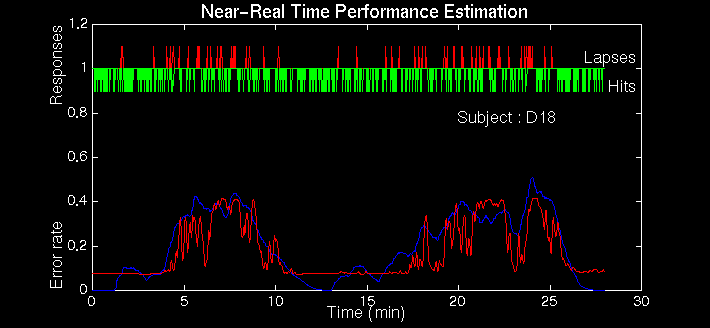Real-Time Alertness Monitoring
List of Relevant Publications: Alertness/Vigilance Monitoring
Basic Paper:
Makeig S, and Inlow M, 1993
Latest Paper:
A visuomotor task for vigilance research: S. Makeig and M. Jolley, CTT: A compensatory tracking task for monitoring alertness (.pdf 50k), Technical Document 96-3C Naval Health Research Center, San Diego, 1996 Download the executable, technical document, and (Borland C++) source code. NOTE: Satisfactory timing and operation of the code have NOT been verified for post-1996 versions of Windows -- Check its performance carefully before using.
-
The Neural Human-System Interface (NHSI) technology concept
- A NIPS95 Post-conference Workshop on NHSI technology.
Estimating Changes in the Level of Alertness from the EEG Power Spectrum
Scott Makeig
Tzyy-Ping Jung
|
Description of Sample Session

The figure above shows results of alertness estimation
in a typical experimental session. During a half-hour session,
the operator struggles to remain alert while performing
a continuous monitoring task --
pressing a response button each time he hears a noise burst target.
The task simulates a submarine sonar operator listening for a sound
signature of the presence of another vessel.
The upper panel shows the operator's responses
to the targets -- RED pulses represent failures to respond
to presented targets, while GREEN downward pulses represent
successful detections by the operator.
When the operator is alert, he easily detects and responds to each
of the targets. As the operator loses alertness and
becomes drowsy, he begins to miss targets...
The lower panel shows, in BLUE, the time course of error
rate in the session, smoothed from the data for individual targets
shown above it. The RED line shows the real-time error rate
estimate derived wholly from the subject's EEG recorded at two
scalp channels. An individualized model of alertness changes
in the EEG for this subject was derived from data recorded
in a previous session. This model, incorporating spectral
analysis and artificial neural network processing, can
accurately estimate the probability of the subject failing
to detect targets throughout the session.
During the
first ten minutes of this session, the subject experienced
a wave of drowsiness. Despite his best efforts to remain alert, he
was unable to respond to up to one third of the targets presented.
Throughout, the EEG-based error-rate estimate correctly estimated
major changes in the operator's alertness level.
In this experiment,
no feedback was given to the operator.
Experiments showed
that EEG-based error rate estimates can be used to deliver feedback
to operators which can help them to manage their own alertness
and can improve overall monitoring performance.